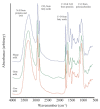Animal Species Authentication in Dairy Products
- PMID: 35454711
- PMCID: PMC9027536
- DOI: 10.3390/foods11081124
Animal Species Authentication in Dairy Products
Abstract
Milk is one of the most important nutritious foods, widely consumed worldwide, either in its natural form or via dairy products. Currently, several economic, health and ethical issues emphasize the need for a more frequent and rigorous quality control of dairy products and the importance of detecting adulterations in these products. For this reason, several conventional and advanced techniques have been proposed, aiming at detecting and quantifying eventual adulterations, preferentially in a rapid, cost-effective, easy to implement, sensitive and specific way. They have relied mostly on electrophoretic, chromatographic and immunoenzymatic techniques. More recently, mass spectrometry, spectroscopic methods (near infrared (NIR), mid infrared (MIR), nuclear magnetic resonance (NMR) and front face fluorescence coupled to chemometrics), DNA analysis (real-time PCR, high-resolution melting analysis, next generation sequencing and droplet digital PCR) and biosensors have been advanced as innovative tools for dairy product authentication. Milk substitution from high-valued species with lower-cost bovine milk is one of the most frequent adulteration practices. Therefore, this review intends to describe the most relevant developments regarding the current and advanced analytical methodologies applied to species authentication of milk and dairy products.
Keywords: adulteration; analytical methods; authenticity; dairy products; milk.
Conflict of interest statement
The authors declare no conflict of interest.
Figures




References
-
- Downey G. Advances in Food Authenticity Testing. Woodhead Publishing; Duxford, UK: 2016.
-
- Committee on the Environment, Public Health and Food Safety Draft Report the Food Crisis, Fraud in the Food Chain and the Control Thereof (2013/2091(INI)) [(accessed on 11 June 2021)]. Available online: https://www.europarl.europa.eu/doceo/document/ENVI-PR-519759_EN.pdf?redi....
-
- Amaral J.S.M.I., Pissard A., Pierna J.A.F., Baeten V. Milk and milk products. In: Morin J.-F., Lees M., editors. Foodintegrity Handbook. Eurofins Analytics France; Nantes, France: 2018. pp. 3–26.
Publication types
Grants and funding
- UIDB/00690/2020/Fundação para a Ciência e Tecnologia
- UIDB/50006/2020 | UIDP/50006/2020/Fundação para a Ciência e Tecnologia
- NORTE-01-0145-FEDER-000052/European Union through European Regional Development Fund
- 2021.08119.BD/Fundação para a Ciência e Tecnologia
- 2021.03670.CEECIND/ERA-Net Cofund: ERA-HDHL nº 696295 and to Fundação para a Ciência e a Tecnologia
LinkOut - more resources
Full Text Sources
Other Literature Sources
Miscellaneous

